10 days in eastern Senegal
On February 9th we headed east from Dakar towards Matam, a town on the Senegal River. This is where we rescued manatees trapped behind a dam in January 2009, and it’s the place where manatees migrate in the rainy season onto a huge floodplain to feed on submerged grasses and plants in this otherwise extremely dry region. It’s a 12 hour drive through dust and many small villages to get to this part of the world, so this time we split the drive up by spending a night at Lac de Guiers and arrived in Matam on the 10th.
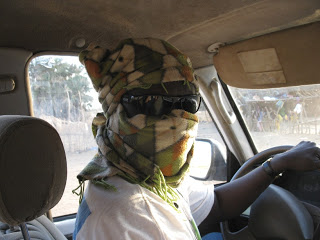 Our first task in Matam was to recover and clean three manatee skeletons that were buried to decompose last November. Unfortunately these three manatees likely died while trying to exit the Navel dam as the waters receded after the rainy season last Fall. Unfortunately grates on the dam doors were not lifted, so they probably drowned trapped up against the grates. Some interested kids watched Tomas and I cleaning skulls. We hope at least the bones of this rare species will be useful for science and educational purposes in Senegal.
Our first task in Matam was to recover and clean three manatee skeletons that were buried to decompose last November. Unfortunately these three manatees likely died while trying to exit the Navel dam as the waters receded after the rainy season last Fall. Unfortunately grates on the dam doors were not lifted, so they probably drowned trapped up against the grates. Some interested kids watched Tomas and I cleaning skulls. We hope at least the bones of this rare species will be useful for science and educational purposes in Senegal.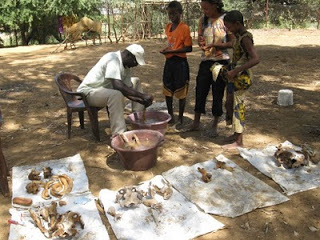 This is the burial site, in view of the dam that unfortunately killed them.
This is the burial site, in view of the dam that unfortunately killed them.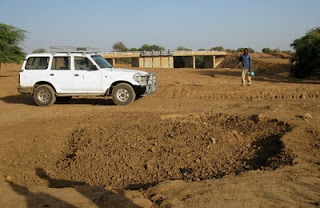 After the skulls, we checked on the rest of the bones, but found that due to the extremely dry soil (it hasn’t rained here since August) they haven’t finished decomposing. So we collected a few more, but we’ll have to wait for the rest.
After the skulls, we checked on the rest of the bones, but found that due to the extremely dry soil (it hasn’t rained here since August) they haven’t finished decomposing. So we collected a few more, but we’ll have to wait for the rest.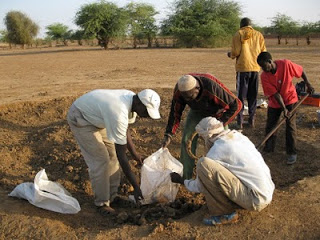
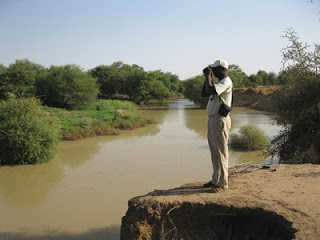
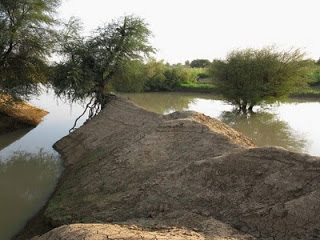
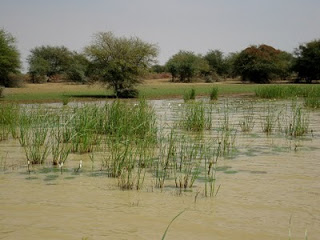
(Photo T. Diagne)![]() Coming in from tracking (photo T. Diagne)
Coming in from tracking (photo T. Diagne)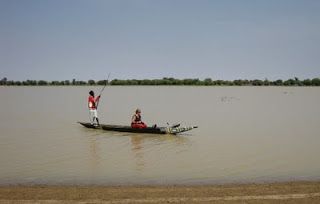 The last site we visited was Patowel, another part of the tribuary cut off from the main Senegal River, approximately 7km long. The water here never completely dries up and it’s an important fishing spot for the local people (the fish are refreshed during the rainy season overflow from the main river). Manatees get trapped in here every year and there are almost no plants during the dry season, so they eat fish from the fishermen’s nets. This occurs in other countries as well, and African manatees are reported to eat not only fish but several species of clams throughout Africa, so they are more omnivorous than their Floirida cousins!
The last site we visited was Patowel, another part of the tribuary cut off from the main Senegal River, approximately 7km long. The water here never completely dries up and it’s an important fishing spot for the local people (the fish are refreshed during the rainy season overflow from the main river). Manatees get trapped in here every year and there are almost no plants during the dry season, so they eat fish from the fishermen’s nets. This occurs in other countries as well, and African manatees are reported to eat not only fish but several species of clams throughout Africa, so they are more omnivorous than their Floirida cousins!
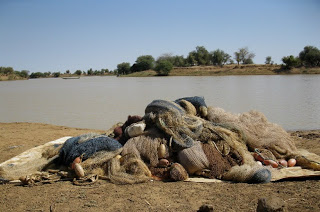 Patowel fisherman cast netting. They also use large nets across the entire river, which manatees break through. It’s challenging to explain to the fishermen that if they don’t want their nets broken, they are going to have to alter their fishing practices and leave an open space for manatees to pass by… they would not welcome hearing this from an outsider, so I discussed this with the local fisheries representative, a very enthisiastic guy who is very interested to try to find good solutions for both fishermen and manatees.
Patowel fisherman cast netting. They also use large nets across the entire river, which manatees break through. It’s challenging to explain to the fishermen that if they don’t want their nets broken, they are going to have to alter their fishing practices and leave an open space for manatees to pass by… they would not welcome hearing this from an outsider, so I discussed this with the local fisheries representative, a very enthisiastic guy who is very interested to try to find good solutions for both fishermen and manatees.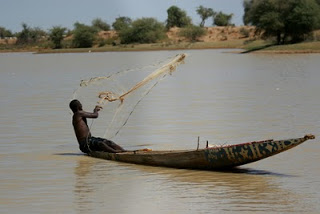 Catfish heads found in fishermen’s nets after the rest of the fish were eaten by manatees.
Catfish heads found in fishermen’s nets after the rest of the fish were eaten by manatees.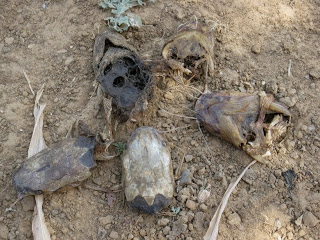 At the end of our tip, Tomas and I attended a 2 day long multi-agency meeting hosted by Wetlands International in Matam. The meeting brought together all the interested parties in manatee issues on the Senegal River- government agencies (manatees are a protected species under the Water and Forestry Ministry, but the water bodies are overseen by the Senegal River Development Authority, and there are also local fisheries departments), NGOs (Wetlands and Oceanium Dakar, both of whom I collaborate with), and local elders from the various villages. There were also several journalists there.
At the end of our tip, Tomas and I attended a 2 day long multi-agency meeting hosted by Wetlands International in Matam. The meeting brought together all the interested parties in manatee issues on the Senegal River- government agencies (manatees are a protected species under the Water and Forestry Ministry, but the water bodies are overseen by the Senegal River Development Authority, and there are also local fisheries departments), NGOs (Wetlands and Oceanium Dakar, both of whom I collaborate with), and local elders from the various villages. There were also several journalists there.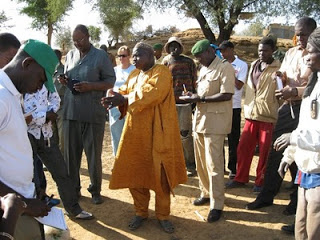 An engineer with the Senegal River Authority discussed the Navel dam… at the Navel dam. I learned alot at this meeting and it was impressive to see all the interest in finding solutions from all the different attendees. (Photo T. Diagne)
An engineer with the Senegal River Authority discussed the Navel dam… at the Navel dam. I learned alot at this meeting and it was impressive to see all the interest in finding solutions from all the different attendees. (Photo T. Diagne)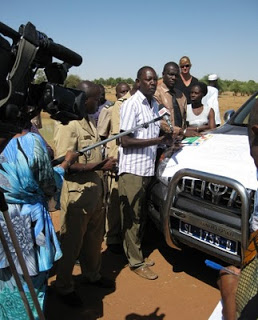 Last but not least, Tomas had learned of some old photos of manatee captures in Matam, and we tracked them down. Unfortunately they had not been well-preserved, but it was still neat to see them. Oceanium began working on manatee rescues here in 1986.
Last but not least, Tomas had learned of some old photos of manatee captures in Matam, and we tracked them down. Unfortunately they had not been well-preserved, but it was still neat to see them. Oceanium began working on manatee rescues here in 1986.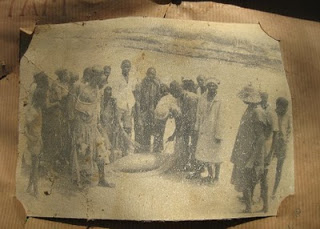 I always enjoy the trips to eastern Senegal, but it’s also good to get back to Dakar and wash off the dust! I’m now planning my next field trip to southern Senegal….
I always enjoy the trips to eastern Senegal, but it’s also good to get back to Dakar and wash off the dust! I’m now planning my next field trip to southern Senegal….
